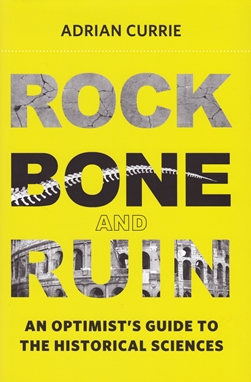
The historical sciences of geology, palaeontology and archaeology are now wonderfully presented on TV. The stories are confidently told - but how much, and how strong, is the evidence for trustworthy interpretations?
Adrian Currie, a philosopher, believes that the historical sciences have been neglected by philosophers. Currie emphasises that although the species or landscapes are now extinct, there is evidence from this unobservable deep past for their reconstruction and understanding. This evidence, the records of a rock, bone, tooth, fossilised footprint or perhaps coprolite, are very meagre, gappy, often degraded or decayed and maybe conflicting; but such things are all we have. We make the best use of it to build theories of development, of the Earth and its life systems.
Currie gives examples of these deductions – for example, of a prehistoric duck-billed platypus and its size from just a single fossilized tooth; or of 'Snowball Earth' through the morphology of sparse glacial deposits. Some evidence is stronger than others, and Currie gives discourse on such points as how a bone might give a suggestion of animal's size, or age, or (from a jaw-bone) evidence of diet. He finds the evidence not so convincing on weight, because the weight requires knowledge of the density of the body, and from the nature of any footprints hints about the gait and general behaviour.
While reviewing 'Rock, Bone, and Ruin' I attended a lecture by David Norman entitled 'Could we ever know how dinosaurs thought or behaved?' (Geological Society of London Public Lecture Series, (
https://www.youtube.com/watch?v=KB2Q9ARMEbE). This lecture presented many lovely further examples of precisely the points that Currie discusses - of how lines of evidence and deduction - in forensic style, including our knowledge of living creatures that are distant relatives – can be used to create plausible pictures of nature in the deep and only indirectly ‘observable’ past.
Currie hopes that his book will have broad appeal, and that his arguments will make sense to non-philosophers. But although absorbing, I am not sure how wide his non-philosophical readership will be. The book certainly needs a glossary to give clear definitions of his philosophical terms. The book is an intriguing read however, presenting a thought-provoking discussion of the reasoning processes and methodologies whereby sparse traces of evidence can be put together to re-create the vanished.
Reviewed by: Richard Dawe
ROCK, BONE, AND RUIN: AN OPTIMIST'S GUIDE TO THE HISTORICAL SCIENCES, by ADRIAN CURRIE, 2018. Published by The MIT University Press, Cambridge, MA.,372pp, (hbk) ISBN 978-0-262-03726-6. List price £27.95. W:
http://mitpress.mit.edu/contributors/adrian-currie98